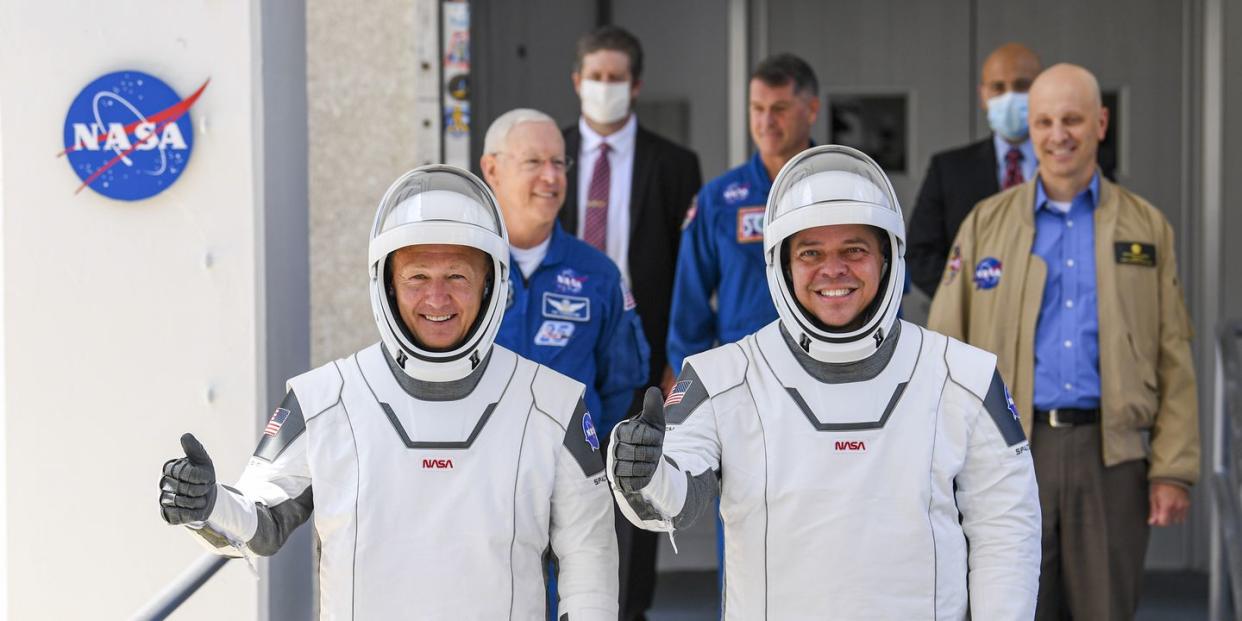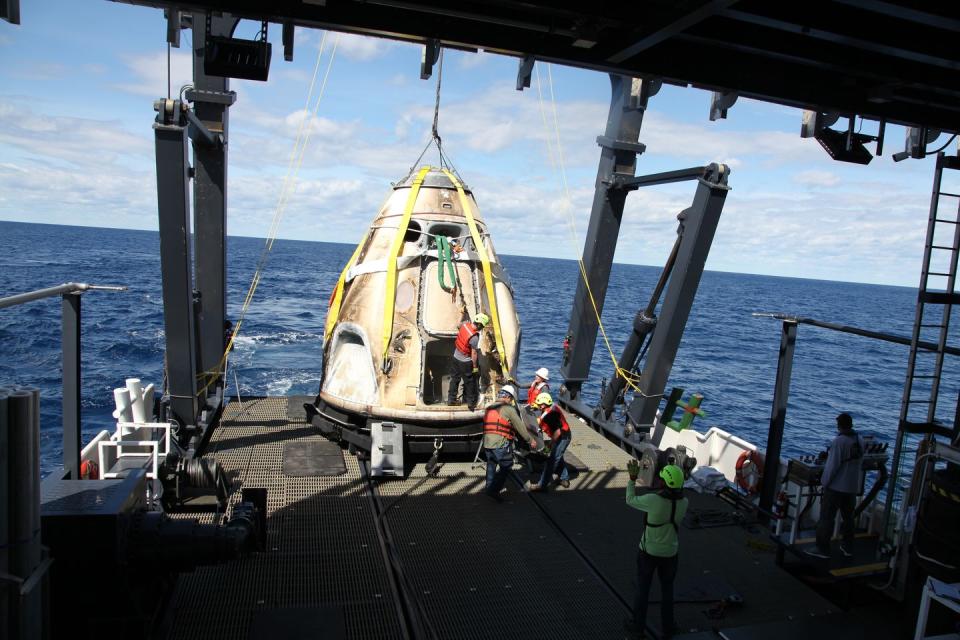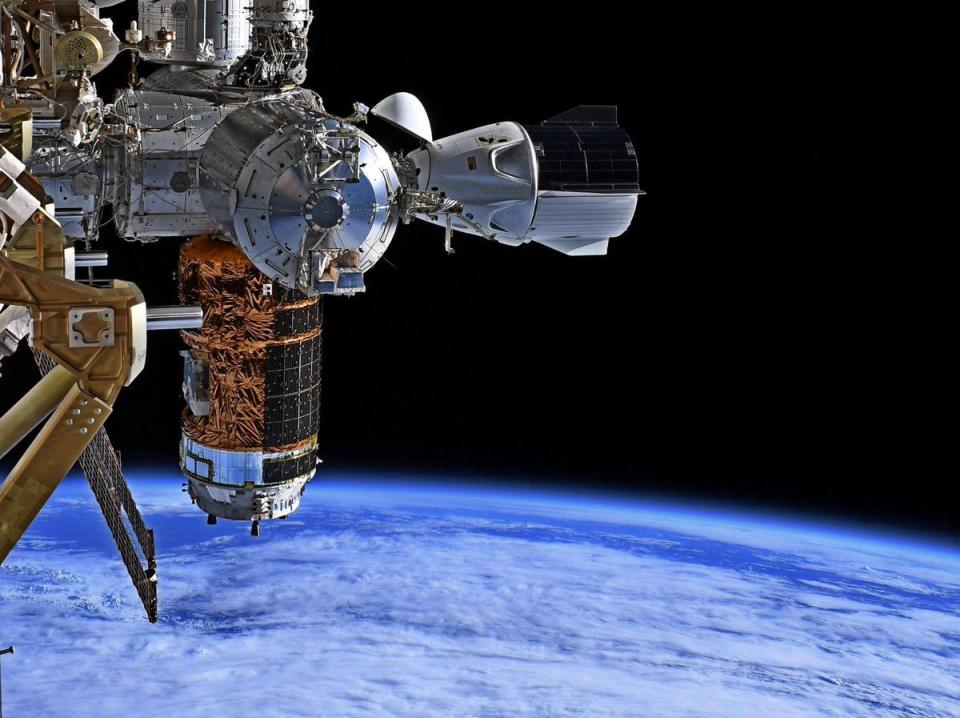Splashdown Is a Success! Bob and Doug Are Safely Back on Earth.

Astronauts Bob Behnken and Doug Hurley, who launched aboard SpaceX's Crew Dragon capsule in May, are scheduled to return home this weekend.
The crew plans to undock from the International Space Station on Saturday and splashdown off the Florida coast on Sunday at 2:48 p.m. ET.
As Tropical storm Isaias closes in on the Florida, NASA and Space are monitoring weather conditions.
Update: 08/02/20 4:00 p.m. ET: After a short delay due to traces of potentially fumes detected outside the capsule, Bob and Doug have finally exited the vehicle through Crew Dragon's side hatch.
Update: 08/02/20 3:02 p.m. ET: We have Splashdown! NASA astronauts Bob Behnken and Doug Hurley have safely splashed down off the coast of Florida in the Gulf of Mexico.
A SpaceX recovery team is now onsite and will conduct a leak check to ensure no fuel or fumes are leaking from the vehicle. Within the hour, they'll be scooped out of the water by SpaceX's Go Navigator vessel and returned to land for a medical evaluation.
Update 08/01/20 7:36 p.m. ET: The undocking sequence has begun! Strapped tightly into SpaceX's Crew Dragon capsule, NASA astronauts Bob Behnken and Doug Hurley have officially kicked off the final stages of their incredible journey.
NASA and SpaceX are planning to bring astronauts Bob Behnken and Doug Hurley home from the International Space Station on Sunday. Behnken and Hurley have spent nearly two months aboard the space station since their historic launch aboard SpaceX's Crew Dragon capsule at the end of May.
Now, for the first time since the Apollo missions, NASA is planning to splash astronauts down in the Atlantic Ocean—that's if the weather cooperates. Tropical storm Isaias, which is currently bearing down on the Florida coast, may throw a wrench into NASA's plans.
"Just like when we launched, we had some challenges with weather. We may have that again," NASA Administrator Jim Bridenstine said during a July 30 press briefing. "But the first opportunity remains Aug. 2 and we look forward to seeing if that's going to be within the realm of what is possible. "
There are seven possible locations off the Florida coast where the duo could land: Pensacola, Panama City, Tallahassee, Tampa, Cape, Daytona, and Jacksonville. Currently, the two northernmost sites on the west coast of Florida, Pensacola and Panama City, look especially promising.
If you'd like to keep track of their progress, you can follow along on NASA's social media feeds. The agency will also be livestreaming the astronauts' journey home.
From Undock to Splashdown

The journey home will officially begin once Behnken and Hurley undock from the International Space Station. They'll get a wake-up call at 8:30 a.m. ET and prepare to disembark from the space station. After a ceremonial send-off, Crew Dragon will undock from the ISS at 7:35 p.m. ET—weather permitting, of course. Once the duo say their goodbyes and unhook from the ISS, Crew Dragon will perform a series of burns to maneuver itself away from the space station.
Depending on how smoothly things go, it could take anywhere between six and 30 hours for the pair to get home. Hours after they've undocked, the vehicle will perform a departure phasing burn and drop the trunk of the spacecraft. This sequence will set Behnken and Hurley up to deorbit the next day at 1:56 p.m ET on Sunday, Aug. 2.
When reentering Earth's atmosphere, the 21,200-pound capsule will experience temperatures reaching 3,500 degrees Fahrenheit. At an altitude of about 18,000 feet, a set of two parachutes will deploy. Four more will deploy at 6,000 feet. Behnken and Hurley should splash down at 2:48 p.m. ET.
"Depending on landing location and needs, we have the ability to bring them back very quickly via helicopter or come back on boat."
SpaceX will have a series of experts—from spacecraft engineers to trained medical professionals—ready to greet Behnken and Hurley once they hit the water. Two ships, Go Searcher and Go Navigator will be stationed off either coast of Florida ready to recover the capsule and its crew.
Two fast boats will be deployed upon splashdown, according to NASA. One will perform a safety check on the vehicle while the other will search for the vehicle's parachutes. Once Crew Dragon is secure, the larger vessel will move in to scoop it out of the sea. Extracting Crew Dragon from the water should take about 45 minutes to an hour, according to NASA.
Both Behnken and Hurley will then be assessed by medical professionals as they make their way back to shore. "Depending on landing location and needs, we have the ability to bring them back very quickly via helicopter or come back on boat," director of crew mission management at SpaceX Benji Reed said during the press briefing. The astronauts will be checked by medical professionals again once they reach shore and then they'll be cleared to see their families again.
"This whole process, of course, is a test mission and, as we do this, we're again giving all the same attention that we would for every crew mission and also extra attention to observe all of the data and observe everything that is happening," Reed said. "This is really critical. "
Weathering the Storm

Of course, the weather may not cooperate. Choppy seas, lightning and rain could jeopardize the mission. Wind speeds greater than 10 miles per hour could force the cancellation of the return mission. "This is to protect how the vehicle actually lands in the water and how the water will come up and surround the vehicle at touchdown,"Steve Stich, the manager of NASA’s Commercial Crew Program, said in a video posted to NASA's twitter account."
If tropical storm Isaias takes a turn for the worse, there are several opportunities at which NASA and SpaceX could postpone the trip, such as 24 hours, six hours and two hours before the crew undocks from the ISS. "We have a series of sites and many days in the future," Stich said during the press briefing. "We have plenty of opportunities here in August and we're in no hurry to come home."
If, for some reason, NASA and SpaceX decide to postpone reentry between the time that Behnken and Hurley undock and when they conduct their reentry burn, the astronauts have enough supplies onboard the capsule to last them a few days. "We have roughly three days of consumables once we undock," Stich said, referring to resources like oxygen, fuel and food.
A safe and successful splashdown will mark the final chapter of the Demo-2 mission. Behnken and Hurley made history on May 30 when they blasted off from the famed Launch Complex 39A at NASA's Kennedy Space Center aboard a SpaceX Crew Dragon capsule. It marked the first time astronauts had ever crewed a commercial space vehicle and return of crewed spaceflight to American soil since the shuttle days.
"It is not over yet: Entry, descent and landing is ahead of us," NASA Administrator Jim Bridenstine said. "Certainly, we're very excited to get Bob and Doug back home and get on with Crew-1 and Crew-2."
Once the crew splashes down, SpaceX and NASA will begin to assess the vehicle's performance. In late September, the agency plans to launch the Crew-1 mission. Three NASA astronauts and a JAXA astronaut will blast off in a separate Dragon capsule. All data collected during the Demo-2 test mission will inform decisions made about future missions.
"There's a lot of work to be done," Bridenstine said.
You Might Also Like

